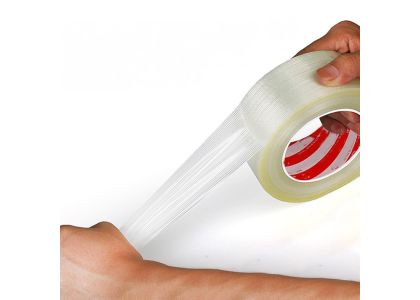
Filament tape manufacturers recognize filament tape as an essential tool widely used in various industries for securing, bundling, and reinforcing packages or heavy items. Understanding the different types of filament strapping tapes is crucial when selecting the best option for your applications. In this analysis, we will focus particularly on fiberglass reinforced strapping tape, its features, advantages, and ideal applications, while briefly highlighting the characteristics of other common filament tapes, including bi-directional fiberglass tape and mono directional filament tape. We also provide insights into sourcing from filament tape China suppliers.
Fiberglass reinforced strapping tape is a hybrid material that integrates traditional polypropylene or polyester with embedded fiberglass filaments. This unique combination enhances its strength and durability, making it a standout choice for demanding applications.
Exceptional Tensile Strength: One of the most significant advantages of fiberglass reinforced tape is its exceptionally high tensile strength. The fiberglass filaments provide additional support, making it incredibly resistant to breakage under tension.
Durability: This type of tape is equipped to withstand harsh conditions. It demonstrates excellent resistance to cutting, abrasion, and UV damage, which is critical for outdoor applications or environments where wear and tear are prevalent.
Rigidity: Compared to other filament tapes, fiberglass reinforced versions are less flexible. While this rigidity enhances strength, it may make the tape more challenging to apply around irregularly shaped items.
Cost Considerations: Generally, fiberglass reinforced strapping tape can be more expensive than standard polypropylene or polyester tapes due to the added strength from the fiberglass. However, when considering long-term applications, this cost often proves justifiable in terms of performance.
Due to its strength and durability, fiberglass reinforced tape is particularly well-suited for heavy-duty applications. Industries such as shipping, construction, and automotive frequently rely on this type of tape for securing large, heavy loads. It excels in high-stress environments where reliable binding is crucial.
While fiberglass reinforced strapping tape offers unmatched strength, it is important to consider other options based on specific application needs.
1. Material Composition: A lightweight synthetic polymer.
2. Tensile Strength: Moderate, best for light to medium-duty tasks.
3. Durability: Limited resistance to UV and temperature fluctuations.
4. Application: Ideal for bundling lightweight items in controlled environments.
5. Advantages: Cost-effective and flexible.
6. Disadvantages: Less suitable for heavy-duty applications.
1. Material Composition: Stronger synthetic polymer.
2. Tensile Strength: High, making it ideal for heavy-duty strapping.
3. Durability: Excellent resistance to UV rays and harsh conditions.
4. Application: Commonly used for securing large or heavy items.
5. Advantages: Better environmental resistance compared to polypropylene.
6. Disadvantages: More expensive and less flexible.
1. Material Composition: Highly durable synthetic polymer.
2. Tensile Strength: Superior strength and elasticity.
3. Durability: Excellent wear and temperature resistance.
4. Application: Secure heavy or irregularly shaped loads.
5. Advantages: High strength and flexibility.
6. Disadvantages: Higher cost and can be difficult to handle.
1. Material Composition: Incorporates steel wire for strength.
2. Tensile Strength: Highest among filament tapes, ideal for extreme applications.
3. Durability: Exceptional impact and abrasion resistance.
4. Application: Secure extremely heavy or valuable loads in demanding environments.
5. Advantages: Maximum security and strength.
6. Disadvantages: Very rigid and costly.
When selecting the right type of filament tape, several key factors should be taken into account:
Strength Requirements: Consider the weight and fragility of the materials being strapped. For lightweight applications, polypropylene may suffice, whereas fiberglass reinforced or steel reinforced options are better suited for heavy or bulkier items.
Environmental Conditions: If the tape will be exposed to sunlight, moisture, or extreme temperatures, fiberglass reinforced or polyester tapes are preferable.
Application Type: The ease of application can vary significantly between types of tape. If flexibility is required, solutions like nylon or polypropylene may be ideal.
Cost Efficiency: Evaluate your specific needs in relation to cost. For everyday use, less expensive options may suffice, but for specialized applications demanding superior strength and durability, investing in fiberglass or steel reinforced tape is often warranted.
Selecting the best strapping tape is critical in securing and bundling items effectively. Fiberglass reinforced strapping tape stands out for its strength and durability, making it optimal for high-stress and heavy-duty applications. On the other hand, understanding other options such as polypropylene, polyester, nylon, and steel reinforced tapes can help tailor your choice to specific needs. Additionally, consulting with filament tape manufacturers or sourcing from filament tape China suppliers can provide valuable insights and options tailored to various applications. Ultimately, the best choice hinges upon a comprehensive understanding of your specific strapping requirements.